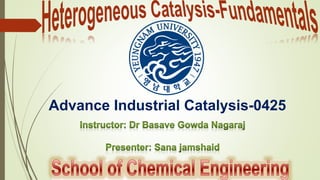
Heterogeneous catalysis-Fundamentals
- 2. Contents 1.Introduction 2.Types of Heterogeneous catalyst 3.Preparation of Heterogeneous catalyst 4. Characterization of Heterogeneous Catalysts 5.Steps involved in heterogeneous catalysis 6.Catalyst Deactivation 7. Industrial Heterogeneous catalysis 8. Conclusion
- 3. If the catalyst is present in а different phase than the reactants, it is called а heterogeneous catalyst and this type of catalysis is called heterogeneous catalysis. Pt, 8000С 4NH3 + 5O2 4NO + 6Н2O Heterogeneous catalysis
- 4. Heterogeneous involves more than one phase: usually the catalyst is a solid and the reactants and products are in liquid or gaseous form A heterogeneous catalytic reaction occurs at or very near the fluid-solid interface Reactions between gases-Iiquid are usually mass-transfer limited
- 5. Components of a Typical Heterogeneous Catalyst A. Active phase - metal that provides active sites where the chemical reaction takes place B. Support or Carrier - high surface area oxide which disperses and stabilizes the active phase (adds efficiency, physical strength, sometimes selectivity) C. Promoter(s) - additive which improves catalyst properties, e.g. activity, selectivity, catalyst life
- 6. Catalyst Examples Natural Clays Zeolites Synthetic Crystalline aluminosilicates
- 9. Preparation Of Heterogeneous Catalyst Preparation of solid catalyst The catalyst preparation methods can broadly categorized as follows: • Bulk preparation process: • Impregnation • Physical mixing
- 10. Bulk catalysts • Bulk catalysts also known as precipitated catalysts are mainly produced when the active components are cheap. • The preferred method of production is precipitation. • One or more components in the form of aqueous solutions are mixed and then co precipitated as hydroxides or carbonates. An amorphous or crystalline precipitate or a gel is obtained, which is washed thoroughly until salt free. This is then followed by further steps: drying, shaping, calcination, and activation
- 13. Preparation of catalyst by impregnation Impregnation as a means of supported catalyst preparation is achieved by filling the pores of a support with a solution of the metal salt. The catalyst is prepared either by spraying the support with a solution of the metal compound or by adding the support material to a solution of a suitable metal salt, This is then followed by drying and subsequent decomposition of the salt at an elevated temperature, either by thermal decomposition or reduction.
- 15. Physical mixing Mixed agglomerated catalysts are prepared by this method. These catalysts are prepared by physically mixing the active substances with a powdered support or precursors of support in ball mill. The final mixture is then agglomerated and activated.
- 17. Catalyst Characterization Characterization of heterogeneous catalyst refers to the determination of its physical and chemical characteristics, which are responsible for its performance in a reaction. Characteristics of catalysts include: • Chemical composition of the bulk and surface of the solids • Surface area and porosity ( micro, meso and macro) • Bulk solid structure, phase composition, crystallite size • Surface morphology
- 18. • Surface chemical properties such as: location and oxidation state of active metals acid-base property reducible – oxidizable property • Aggregate properties such as aggregate or particle size, density, mechanical strength and attrition resistance • Catalytic properties : activity , selectivity, stability
- 19. The heterogeneous catalysis is a surface phenomenon. It involves the following steps: Diffusion of the reactants at the surface of the catalyst. Adsorption of the molecules of the reactants at the active sites. Occurrence of the chemical reactions on the surface of the catalyst. Desorption of products molecules from the surface. Diffusion of products away from the surface of the catalyst.
- 22. Catalyst Deactivation It is complex phenomenon which can be defined as loss of catalytic activity and / or selectivity. Time scales for catalyst deactivation vary considerably; for example, in the case of cracking catalysts, catalyst mortality may be in the order of seconds. While in ammonia synthesis the iron catalyst may last for 5–10 years.
- 25. Alkylation and Dealkylation Reactions • Alkylation: addition of an alkyl group to an organic compound • Common catalyst: Friedel-Crafts AlCl3 + HCl
- 26. Alkylation and Dealkylation Reactions • Dealkylation:Cracking of petrochemicals •Common catalyst: silica-alumina; silicamagnesia and even clays (montmorilonite)
- 27. Isomerization Reactions • Change of Structure • Hydrocarbon molecules are rearranged into a more useful isomer • The process is particularly useful in enhancing the octane rating of petrol, as branched alkanes burn more efficiently in a car engine than straight-chain alkanes.
- 28. Hydrogenation and Dehydrogenation Reactions • Some metals used in Hydrogenation are: – Co, Ni, Rh, Ru, Os, Pd, Ir, and Pt. • Non-used metals: – V, Cr, Nb, Mo, Ta, and W – each of which has a large number of vacant dorbitals – These are inactive as a result of the strong adsorption for the reactants or the products or both
- 29. Hydrogenation and Dehydrogenation Reactions • Hydrogenation reactions are favored at lower temperatures (<200ºC) • Dehydrogenation reactions are favored at high temperatures (at least 200ºC) • Example: – Industrial butadiene (synthetic rubber production) can be obtained by the dehydrogenation of butenes.
- 30. Oxidation Reactions • The transition group elements (group VIII) and subgroup are used extensively in oxidation reactions: – Ag, Cu, Pt, Fe, Ni • In addition, V2O5 and MnO2 are frequently used for oxidation reactions
- 31. Hydration and Dehydration Reactions • Used to get rid of H2O molecules • Hydration and dehydration catalysts have a strong affinity for water • One such catalyst is AI2O3, which is used in the dehydration of alcohols to form olefins
- 32. Hydration and Dehydration Reactions Other examples: – Clays – Phosphoric acid – Phosphoric acid salts on inert carriers
- 33. HaIogenation and DehaIogenation Reactions • Addition of Halogens Elements (group 7) • Cl, F, Br, I, etc… • Typical catalysts: CuCI2, AgCI. Pd, AlBr3, CCl4
- 34. Conclusion Heterogenous catalysis over Homogeneos